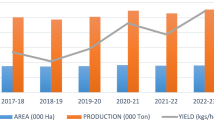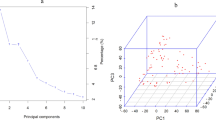Summary
An understanding of the genetic nature underlying tolerance to low-phosphorus (low-P) stress could aid in the efficient development of tolerant plant strains. The objective of this study was to identify the number of loci in a maize (Zea mays L.) population segregating for tolerance to low-P stress, their approximate location, and the magnitude of their effect.
Seventy-seven restriction fragment length polymorphisms (RFLPs) were identified and scored in a maize F2 population derived from a cross between line NY821 and line H99. The F2 individuals were self-pollinated to produce F3 families. Ninety F3 families were grown in a sand-alumina system, which simulated diffusion-limited, low-P soil conditions. The F3 families were evaluated for vegetative growth in a controlled-environment experiment. To identify quantitative trait loci (QTLs) underlying tolerance to low-P stress, the mean phenotypic performances of the F3 families were contrasted based on genotypic classification at each of 77 RFLP marker loci.
Six RFLP marker loci were significantly associated with performance under low-P stress (P<0.01). One marker locus accounted for 25% of the total phenotypic variation. Additive gene action was predominant for all of the QTLs identified. Significant marker loci were located on four separate chromosomes representing five unlinked genomic regions. Two marker loci were associated with an additive by additive epistatic interaction. A multiple regression model including three marker loci and the significant epistatic interaction accounted for 46% of the total phenotypic variation. Heterozygosity per se was not predictive of phenotypic performance.
Similar content being viewed by others
References
Bernatzky R, Tanksley SD (1986) Toward a saturated linkage map in tomato based on isozymes and random cDNA sequences. Genetics 112:887–898
Birnboim HC (1983) A rapid alkaline extraction method for the isolation of plasmid DNA. In: Wu R, Grossman L, Moldave K (eds) Methods in enzymology, vol. 100: recombinant DNA, part B. Academic Press, New York, pp 243–255
Coltman RR, Gerloff GC, Gabelman WH (1982) A sand culture system for simulating responses to phosphorus in soil. J Am Soc Hortic Sci 107:938–942
Coltman RR, Gerloff GC, Gabelman WH (1985) Differential tolerance of tomato strains to maintained and deficient levels of phosphorus. J Am Soc Hortic Sci 110:140–144
Coltman RR, Gerloff GC, Gabelman WH, Barta S (1987) Genetics and physiology of low-phosphorus tolerance in a family drived from two differentially adapted strains of tomato (Lycopersicon esculentum Mill.). In: Gabelman WH, Loughman BC (eds) Genetic aspects of plant mineral nutrition. Martinus Nijhoff Publ. The Hague, The Netherlands, pp 309–316
Edwards MD, Stuber CW, Wendel JF (1987) Molecular-markerfacilitated investigations of quantitative-trait loci in maize. I. Numbers, genomic distribution and types of gene action. Genetics 116:113–125
Fawole I, Gabelman WH, Gerloff GC (1982a) Genetic control of root development in beans (Phaseolus vulgaris L.) grown under phosphorus stress. J Am Soc Hortic Sci 107:98–100
Fawole I, Gabelman WH, Gerloff GC, Nordheim R (1982b) Heritability of efficiency in P utilization in beans (Phaseolus vulgaris L.) grown under P stress J Am Soc Hortic Sci 107:94–97
Feinberg A, Vogelstein B (1983) A technique for radiolabeling DNA restriction endonuclease fragments to high specific activity. Anal Biochem 132:6–13
Fox RH (1978) Selection for P efficiency in corn. Commun Soil Sci Plant Anal 9:3–39
Furlani AMC, Clark RB, Maranville JW, Ross WM (1984) Sorghum genotype differences in phosphorus uptake rate and distribution in plant parts. J Plant Nutr 7:1113–1126
Gerloff GC, Gabelman WH (1983) The search for and interpretation of genetic controls that enhance plant growth under deficiency levels of a macronutrient. Plant Soil 72:335–350
Helentjaris T, King G, Slocum M, Siedenstrang C, Wegman S (1985) Restriction fragment polymorphisms as probes for plant diversity and their development as tools for applied plant breeding. Plant Mol Biol 5:109–118
Helentjaris T, Slocum M, Wright S, Schaefer A, Nienhuis J (1986) Construction of genetic linkage maps in maize and tomato using restriction fragment length polymorphisms. Theor Appl Genet 72:761–769
Johnson DA, Gautsch JW, Sportsman JR, Elder JH (1984) Improved technique utilizing nonfat dry milk for analysis of proteins and nucleic acids transferred to nitrocellulose. Gene Anal Technol 1:3–8
Kahler AL, Wehrhahn CF (1986) Associations between quantitative traits and enzyme loci in the F2 population of a maize hybrid. Theor Appl Genet 72:15–26
Lander ES, Green P, Abrahamson J, Barlow A, Daly MJ, Lincoln SE, Newburg L (1987) Mapmaker: An interactive computer package for constructing genetic linkage maps of experimental and natural populations. Genomics 1:174–181
Landry BS, Kessili RV, Rarrara B, Michelmore RW (1987) A genetic map of lettuce (Lactuca sativa L.) with restriction fragment length polymorphisms, isozymes, disease resistance genes and morphological markers. Genetics 116:331–337
Maniatis T, Fritsch E, Sambrook J (1982) Molecular cloning: a laboratory manual. Cold Spring Harbor Laboratory Press, Cold Spring Harbor, N.Y.
Martin B, Nienhuis J, King G, Schaefer A (1989) Restriction fragment length polymorphisms associated with water use efficiency in tomato. Science 243:1725–1728
Nienhuis J, Helentjaris T, Slocum M, Ruggero B, Schaefer A (1987) Restriction fragment length polymorphism analysis of loci associated with insect resistance in tomato. Crop Sci 27:797–803
Paterson AH, Lander ES, Hewitt JD, Peterson S, Lincoln SE, Tanksley SD (1988) Resolution of quantitative traits into Mendelian factors by using a complete RFLP linkage map. Nature 335:721–726
Rigby PW, Dieckmann JM, Rhodes C, Berg P (1977) Labeling deoxyribonucleic acid to high specific activity in vitro byn i ck translation with DNA Polymerase I. J Mol Biol 113:237–251
Saghai-Maroof MA, Soliman KM, Jorgensen RA, Allard RW (1984) Ribosomal DNA spacer-length polymorphisms in barley: Mendelian inheritance, chromosomal location, and population dynamics. Proc Natl Acad Sci USA 81:8014–8018
Sanchez PA, Salinas JG (1981) Low input technology for managing Oxisols and Ultisols in tropical America. In: Advances in agronomy, Vol. 34. Am Soc Agron Madison, Wis., pp 279–406
SAS user's guide: statistics, version 5 edition (1985) SAS Institute Inc Cary, N.C., USA
Whitaker GP, Gerloff GC, Gabelman WH, Lindgren D (1976) Intraspecific differences in growth of beans at stress levels of phosphorus. J Am Soc Hortic Sci 101:472–475
Author information
Authors and Affiliations
Additional information
Communicated by A. R. Hallauer
Rights and permissions
About this article
Cite this article
Reiter, R.S., Coors, J.G., Sussman, M.R. et al. Genetic analysis of tolerance to low-phosphorus stress in maize using restriction fragment length polymorphisms. Theoret. Appl. Genetics 82, 561–568 (1991). https://doi.org/10.1007/BF00226791
Received:
Accepted:
Issue Date:
DOI: https://doi.org/10.1007/BF00226791




